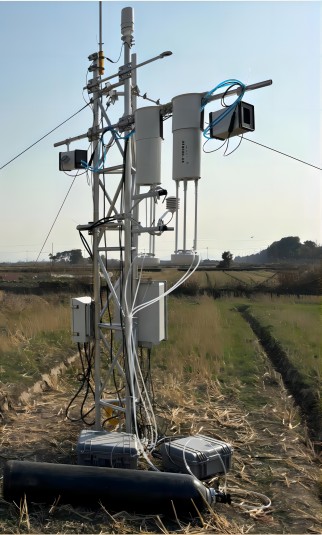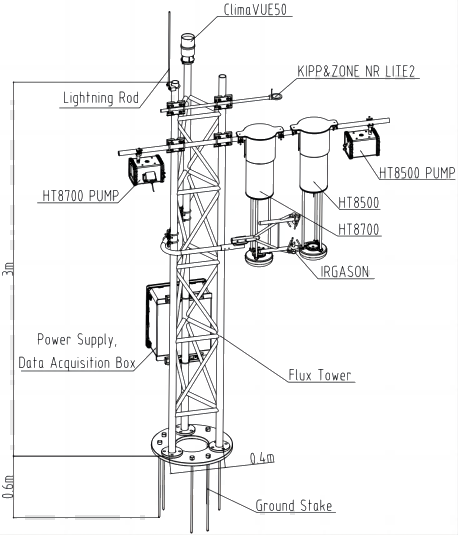Background
Ammonia (NH3) is one of the main atmospheric pollutants and a significant contributor to haze formation. Nitrous oxide (N2O) is the third-largest greenhouse gas globally. Agricultural emissions are a major source of anthropogenic NH3-N2O emissions, and reducing ammonia emissions from farmland is one of the urgent challenges for global sustainable development. Therefore, monitoring NH3-N2O emissions and improving nitrogen fertilizer utilization are crucial.
HealthyPhoton has established an open-path EC NH3-N2O flux synchronous observation system in a farmland in Xianxiang Town, Ningbo City, to monitor agricultural NH3-N2O emissions.
System Components


Site Selection Guidelines for System Installation
1. Choose flat and open ground, away from obstructions, to ensure good airflow and minimize the impact of wind on data.
2. Ensure that the surroundings of the site are relatively stable, avoiding large areas of vegetation, buildings, or other human disturbances.
3. Stay as far away as possible from potential sources of interfering gases, such as farms or industrial emission points, to ensure the accuracy of the analytical data.
4. Consider the climatic characteristics of the site, avoiding extreme weather conditions such as high temperatures, humidity, or strong winds that may adversely affect the system's operation.
5. Avoid exposing the system to air with high concentrations of pollutants to prevent contamination of sensors.
System Installation Points to Note
1. When installing the carbon flux detection system, ensure that the sonic anemometer integrated eddy covariance flux analyzer (IRGASON) is installed perpendicular to the ground and avoid installing sensors in locations prone to human interference.
2. When installing the net radiation sensor (Kipp & Zonen NR Lite2), ensure it is correctly positioned beneath an open sky and away from obstructions to ensure accurate radiation measurement.
3. The bottom of the NH3 and N2O open-path laser analyzers should be approximately 1.4 meters above the ground, with the water tank placed around 0.5 meters away from the main unit. Ensure that the main unit and related modules are securely installed and that the cooling water pump operates properly to maintain the system's stable operating temperature.
4. After completing the system installation, perform system calibration and functional testing to ensure that all sensors and the main unit operate normally, and adjust system parameters to meet monitoring requirements.
Applications
1.Farmland and Forests
2.Pastures and Fisheries
3.Oil and Refinery
4.Construction and Coatings
5.Urban Air Quality
High system integration capabilities meet diverse needs, providing you with ideal solutions.
|
Model |
N2O |
CH4 |
CO2 |
H2O |
NH3 |
|
HT8700 |
|
|
|
|
√ |
|
HT8600 |
|
√ |
|
|
|
|
HT8500 |
√ |
|
|
|
|
|
HT8850 |
√ |
√ |
√ |
√ |
|
|
HT8840 |
|
√ |
√ |
√ |
|
|
HT8830 |
√ |
|
√ |
√ |
|
|
HT8820 |
√ |
√ |
|
√ |
|
|
HT8810 |
|
|
√ |
√ |
|
Related products:
 Tel:+86-400 961 6990 Email:info@healthyphoton.com
Add:Room 305, Building 1, Zhongchuang Science Park, Jinyuan Road, Panhuo Street, Yinzhou District, Ningbo City,China
Tel:+86-400 961 6990 Email:info@healthyphoton.com
Add:Room 305, Building 1, Zhongchuang Science Park, Jinyuan Road, Panhuo Street, Yinzhou District, Ningbo City,China


